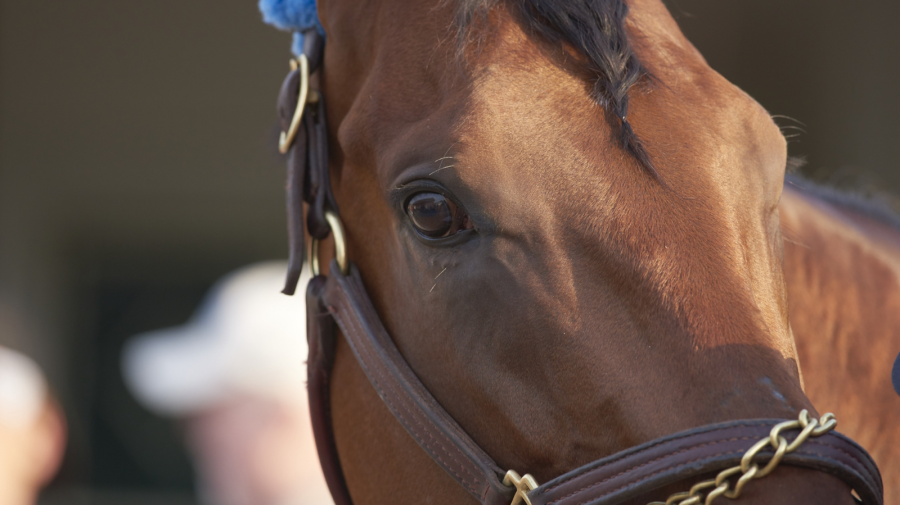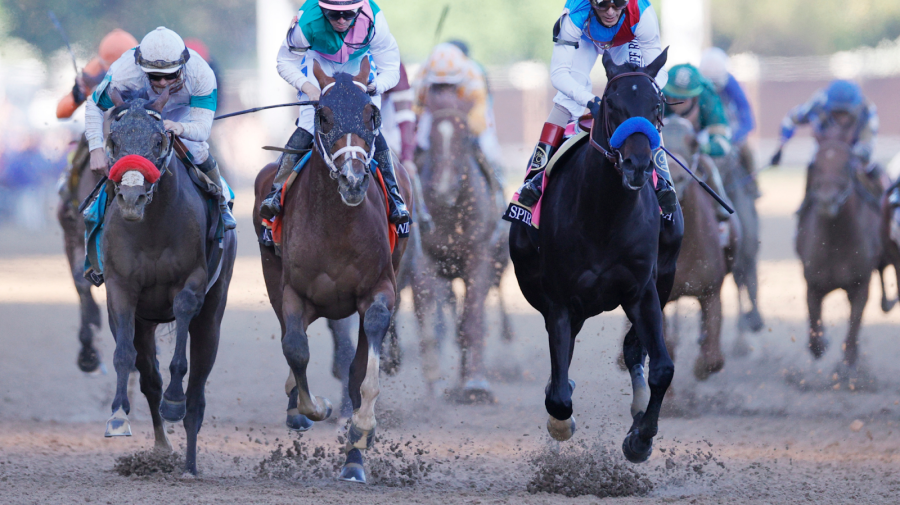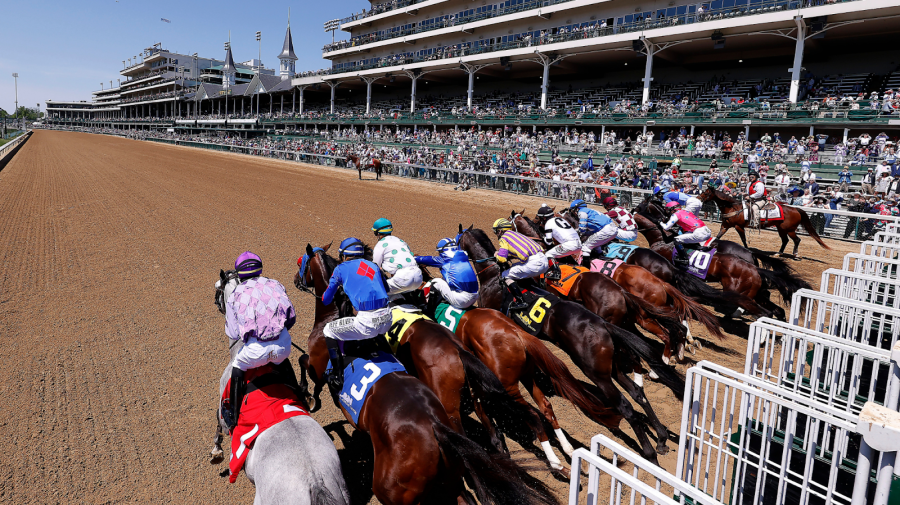How Much Money Does The Jockey Win At Kentucky Derby

Horse racing is a worldwide phenomenon with roots dating dorsum to antiquity. According to the archeological record, human beings kickoff domesticated and rode horses over v,000 years ago. Racing, it stands to reason, couldn't accept been far backside; later on all, people were involved in competitive running at least as far back as ancient Egypt. In some means, racing, in whatever form, is the nearly pure expression of sport: you lot just line upwardly and run into who's faster. Of course, in reality, it's a little more complicated than that.
The most of import event in horse racing in the U.Due south. is the Kentucky Derby — a.yard.a. "The Run for the Roses," named later the ruddy roses that get draped over the winner of the race. Every year, the race takes place at Churchill Downs on the first Saturday of the month of May (this twelvemonth, May 7). The Kentucky Derby, much similar golf's Masters, is an event full of pomp and circumstance. The Derby is besides called "The Virtually Heady 2 Minutes in Sports" considering for all of the hours of coverage and endless rituals involved, that'southward generally how long the race itself takes.
And don't go me incorrect: the Kentucky Derby is heady to watch. I'm not immune to the charms of drinking a mint julep — the Derby is currently sponsored past the bourbon brand, Woodford Reserve — and having an excuse to gather with friends and make a few wagers. Unfortunately, the Derby — and equus caballus racing more broadly — has seen some troubling examples of animal treatment that deserve our attention and thought.
Dangers of Horse Racing Generally

One way of thinking about how dangerous horse racing can be for horses is to consider how dangerous information technology is for the jockeys who ride them. Jockeys go injured all the fourth dimension — the average gets injured three times per twelvemonth — and many of these injuries are the consequences of injuries to horses like collisions and broken legs.
Jockeys, at to the lowest degree, have some agency over the decisions they make about engaging in such a dangerous activity. The horses, nevertheless, are subject to the whims of their owners and the sport itself. Horses generally showtime preparation for racing when they are then immature that their bodies aren't fully mature.
Patrick Battuello, who runs the nonprofit Horseracing Wrongs, tracks deaths of horses "on or at U.S. tracks." Looking at the list for the current yr makes the problem outset to feel very immediate — very existent. According to an op-ed he wrote in the Washington Postal service in 2019, "Death can come up in many forms. Cardiovascular collapse. Pulmonary hemorrhage, or bleeding in the lungs. Blunt-force head trauma from collisions with other horses or the track itself in a autumn. Snapped necks, severed spines, shredded ligaments."
Information technology'south non easy to read that and feel okay about it. These dangers to horses are inextricable from horse racing itself, where horses run at speeds of upwards to 40 miles per 60 minutes in close proximity to other horses trying to race past them. To be sure, virtually all forms of competition behave risk. When the competition involves animals who can't exist given the opportunity to decide whether or not they desire to compete, it becomes even more of import to consider whether the practices of that competition constitute cruelty to those animals.
In 2014, PETA (People for the Ethical Treatment of Animals) released a video based on an hugger-mugger investigation into horse racing practices in the U.Southward. Much of what is in that report is involves animals being injected with drugs to make sure they're able to go on to race through pain and injury. These are extreme cases, presented in an extreme way.

Horse racing, still, does accept cruelty built into the basics of the sport. The use of whips, for case, is standard in horse racing — in 2015, Kentucky Derby winner American Pharaoh was whipped between 29 and 33 times, which is generally thought to exist excessive, simply all the horses are whipped to some caste or other.
It's non merely behavior during races that'due south a trouble, either. According to PETA "x,000 'unprofitable' or simply unwanted Thoroughbreds from the U.S. are trucked to Canada and Mexico and slaughtered each year." Still, the manufacture "continues to churn out nearly 20,000 Thoroughbred foals annually." That's an alarming ratio, and it highlights the fact that many horse owners aren't seeing their animals through an entire lifetime of intendance.
The Kentucky Derby, Specifically
In many ways, what goes on in the context of the Kentucky Derby is but a microcosm of the culture of horse racing, at least in the U.S. In other ways, it'southward a different story. According to NPR, the state of Kentucky allows race tracks to go along deaths of horses confidential, and that'southward not a policy other states let.
Bob Baffert, the legendary horse trainer whose horses have won the Kentucky Derby a record six times, is currently serving a two-year break from the Derby. He was suspended subsequently the horse he was training last year, Medina Spirit — later winning the Derby — tested positive for a steroid called betamethasone. This, combined with Baffert's previous record of other testing failures, led to the ban. Medina Spirit, sadly, died in December of 2021 while training. The fact that the Derby had to take away what would have been Baffert's seventh win is a blackness mark on the race itself, though it does at to the lowest degree testify what could be the beginning of more accountability in the sport.

That would exist, at to the lowest degree to a pocket-sized degree, a step in the correct management. After all, as Larry Demeritte, a equus caballus trainer whose equus caballus was euthanized afterward an injury at Churchill Downs in 2019, put it in an interview with NPR, "I would like to meet…people trust u.s. more than in the game. The more secretive you lot are…people always say, there's something shady about it."
Information technology'southward true: secrecy is never a expert long-term solution. Eventually, the truth gets revealed, as investigations like PETA's in 2014 make articulate. On the other paw, transparency doesn't solve everything, either. It's possible that, culturally, folks in the U.S. are losing the stomach for enjoyment of a sport that involves whipping and pushing animals past their limits. Later on all, the Iditarod sled dog race in Alaska has been bailiwick to like scrutiny in recent years. It isn't plenty that these cultural institutions have long histories. Every bit we alter, maybe they must change too.
Source: https://www.ask.com/culture/how-are-horses-treated-at-kentucky-derby?utm_content=params%3Ao%3D740004%26ad%3DdirN%26qo%3DserpIndex
Posted by: sandersstlef1950.blogspot.com

0 Response to "How Much Money Does The Jockey Win At Kentucky Derby"
Post a Comment